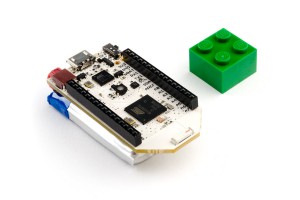Pinoccio is an Arduino-compatible, web-enabled, wireless mesh networking ecosystem. Check out their website for more information, these little boards are awesome!!

Pinoccio Field Scout (Lego for scale)
One of the first things that amazed me about Pinoccio was its ScoutScript feature. This lets you run live commands on your Scout without recompiling! As an embedded engineer I’m so used to the code->compile->download->review process that being able to simply type a command on a microcontroller and see the result is amazing. See this demo I stole from the Pinoccio homepage:
As you can see, there are a lot of things available to play with – temperature, battery charge (that’s the 94%), an RGB LED on the Scout’s PCB, and all the digital and analogue pins are right there too.
I’m a little obsessed with the temperature of things, so I’ll be doing a couple of projects on measuring various temperatures around my home. Let’s have a look at the Pinoccio and then set it up for some data collection.
First step, you need a Pinoccio. The starter kit is recommended – the Lead Scout has a WiFi backpack that acts as a bridge between the Pinoccio 802.15.4 mesh network and your home WiFi. 802.15.4 is far more efficient than WiFi and better suited to this kind of application. Your Lead Scout normally stays plugged in (a USB charger or any spare USB port will do!) and with external power it can support both networks permanently. Your Field Scouts can then be wherever you like (within reason!). They will happily operate on their LiPo battery, while chatting away over the 802.15.4 mesh.
Your Troop also needs to be configured in HQ. HQ is the web-based control desk for all your Scouts (collectively called a Troop). This is a piece of cake to set up, I was done in less than 5 minutes. After unplugging my Scouts I spent far too much time turning the LED of my Field Scout on and off over the wireless mesh (simple things for simple minds?).
The Field Scouts use battery power when unplugged. Out of the box, the Atmel microcontroller is powered up and running all the time. This is snappy and gives instant response to commands sent from HQ, great for prototyping but will drain the battery in a couple of days. If you want to look at something for a few hours, do no more! In fact, that’s exactly what I did – nothing. I unplugged my Field Scout and left it sitting on my work bench. Let’s see what sort of data we can get purely from the out-of-box experience. In a couple of days I’ll have a look at what my Scouts got up to. After that, we can try some more interesting projects.
![]()
